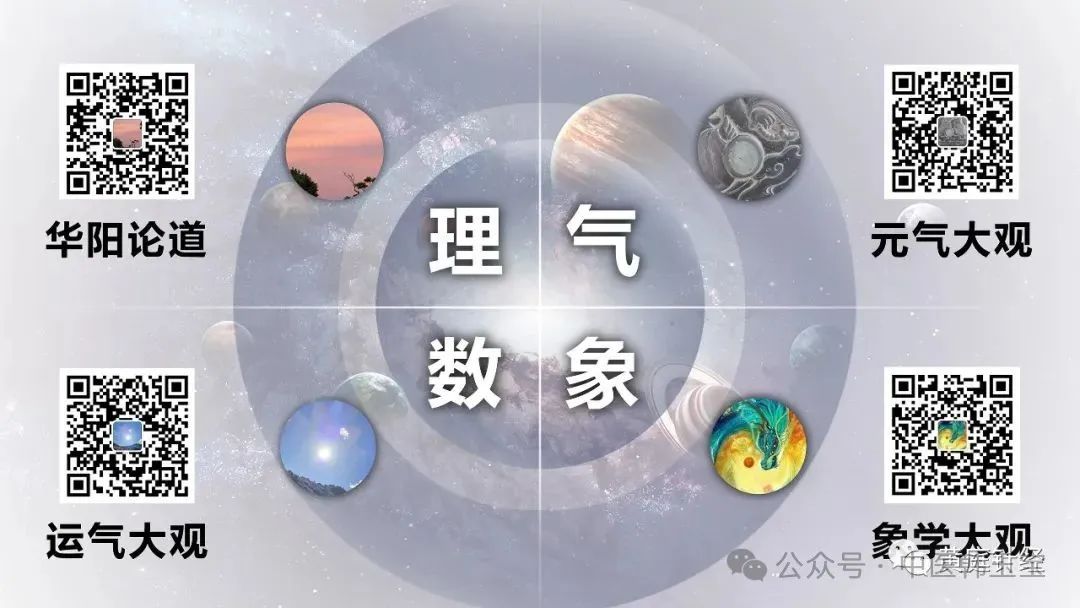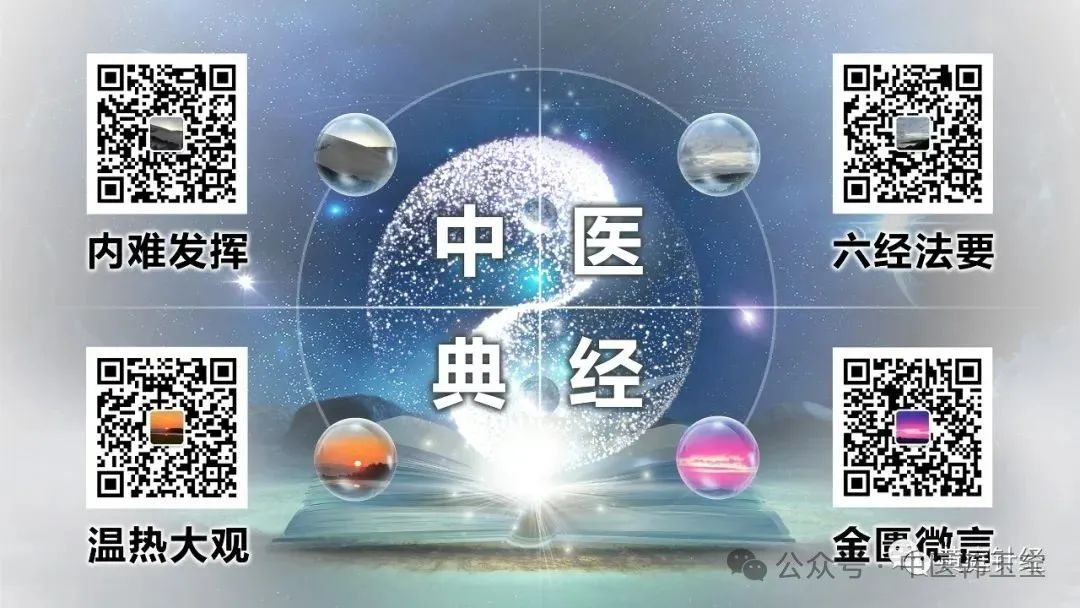Hand Yangming Meridian: Laohe Meridian, Yujie Meridian, Hukou Meridian;Foot Yangming Meridian: Lidui, Fengdui, Fenglong (Fenglong);Hand and Foot Yangming Meridian: Juyang Meridian;Yangming Jueyin Meridian: Sanyang Meridian, Chongyang Meridian;Yangming Shaoyang Meridian: Quepen – Jianjing (Yangwei Meridian);Yangming Du Meridian: Chengshan Meridian;
Volume One
Volume Two: Meridian Theory
Chapter Two: Wu Men Meridian System
Section Three: Yangming Meridian
1. Hand Yangming Meridian
The Hand Yangming Meridian issues a collateral from Hegu, connecting to Neiguan (inner Hegu).
The Neiguan point is located at the radial side of the midpoint of the second metacarpal bone, opposite to the “Hegu” point on the back of the hand, primarily treating deficiency and emaciation, similar to Changqiang.
Hegu is primarily for excess;
Neiguan is primarily for deficiency.
Neiguan connects to Laogong, hence this collateral is named Laohe Meridian. Neiguan and Laogong are in the same disturbance field, both treating Taiyin deficiency. It can be seen that Laogong is not in the Hand Jueyin Pericardium Meridian. The points in the Hand Jueyin Meridian are Xiaotianxin. Neiguan (radial side of the second metacarpal), Neilaogong (between the second and third metacarpals), and Xiaotianxin (above the third metacarpal) are arranged in parallel.
Li Dongyuan stated, “Longxia damp-heat obstructing the spleen, especially suitable for Qingshu Yiqi Decoction,” Qingshu Yiqi Decoction (Huangqi, Cangzhu, Shengma, Renshen, Chaoqu, Jupi, Baizhu, Maidong, Danggui, Zhi Gan Cao, Qingpi, Huangbai, Gegen, Zexie, Wuweizi) corresponds to the Neiguan point..
Laogong is also known as Xiao Jianzhong Decoction. The “Jinkui Yaolue” states, “Labor as a disease, its pulse is floating and large, hands and feet are vexed, severe in spring and summer, cured in autumn and winter.” If the palm is hot, it indicates Laogong’s tidal heat.
Hand Yangming has Yujie Meridian, connecting to the Taiyin Meridian;
There is also Hukou Meridian, connecting to the Dihui point.
The Hukou point is the Dacross point of the Dong’s unique points, invented by the famous TCM practitioner Zuo Changbo.
However, this point is actually recorded in the “Qianjin Fang” and “Qianjin Yifang”, being the point of Master Sun. It treats heart pain, moxibustion at Hukou, invigorating Yang Qi. For vexation and heat headache, it can be needled to drain fire.
This point is not a unique point; it is on the Yangming Meridian, connecting both Earth Fire and Earth Water, thus it can warm Yang and drain fire.
The index finger represents the tiger, the Yangming Meridian runs here, while the thumb represents the dragon, where the Great Dragon Mountain is located, indicating liver pain (i.e., Earth Water, the two points are located on the radial side of the second phalanx of the thumb and the back, which can be considered as one point), converging at Hukou.
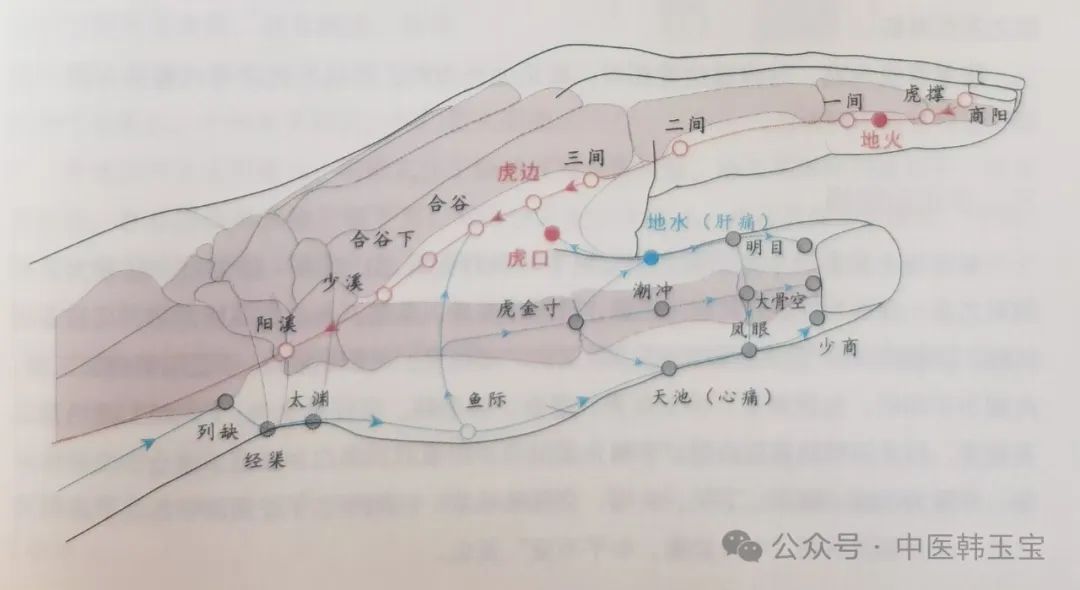 |
2. Foot Yangming Meridian
The Foot Yangming Stomach Meridian ends at the Lidui point.
There are two Lidui points:
One is located on the outer side of the tip of the second toe, 0.1 cun from the corner of the toenail, named Lidui;
The other is about 0.1 cun below the edge of the third toenail, close to the second toe, also known as the second Lidui, named Fengdui in the Wu Men unique points.
This point specifically treats acid reflux and gastroesophageal reflux disease, as the upper part is the Yin Yao with an opening, making reflux easy. If the cardia is closed, the mouth is sealed, which can be treated. This point corresponds to the Zhizi Chih Decoction in the Treatise on Cold Damage. Thus, the Foot Yangming Meridian branches at Neiting and ends at the second and third toes.
Neiting is the open area of the branches.
Neiting corresponds to the pylorus, promoting the downward movement of food into the intestines.
Zhonting corresponds to the cardia, treating food reflux.
When food descends, both acid reflux and reflux can be alleviated. Therefore, Neiting and Fengdui can be needled to increase stimulation intensity.
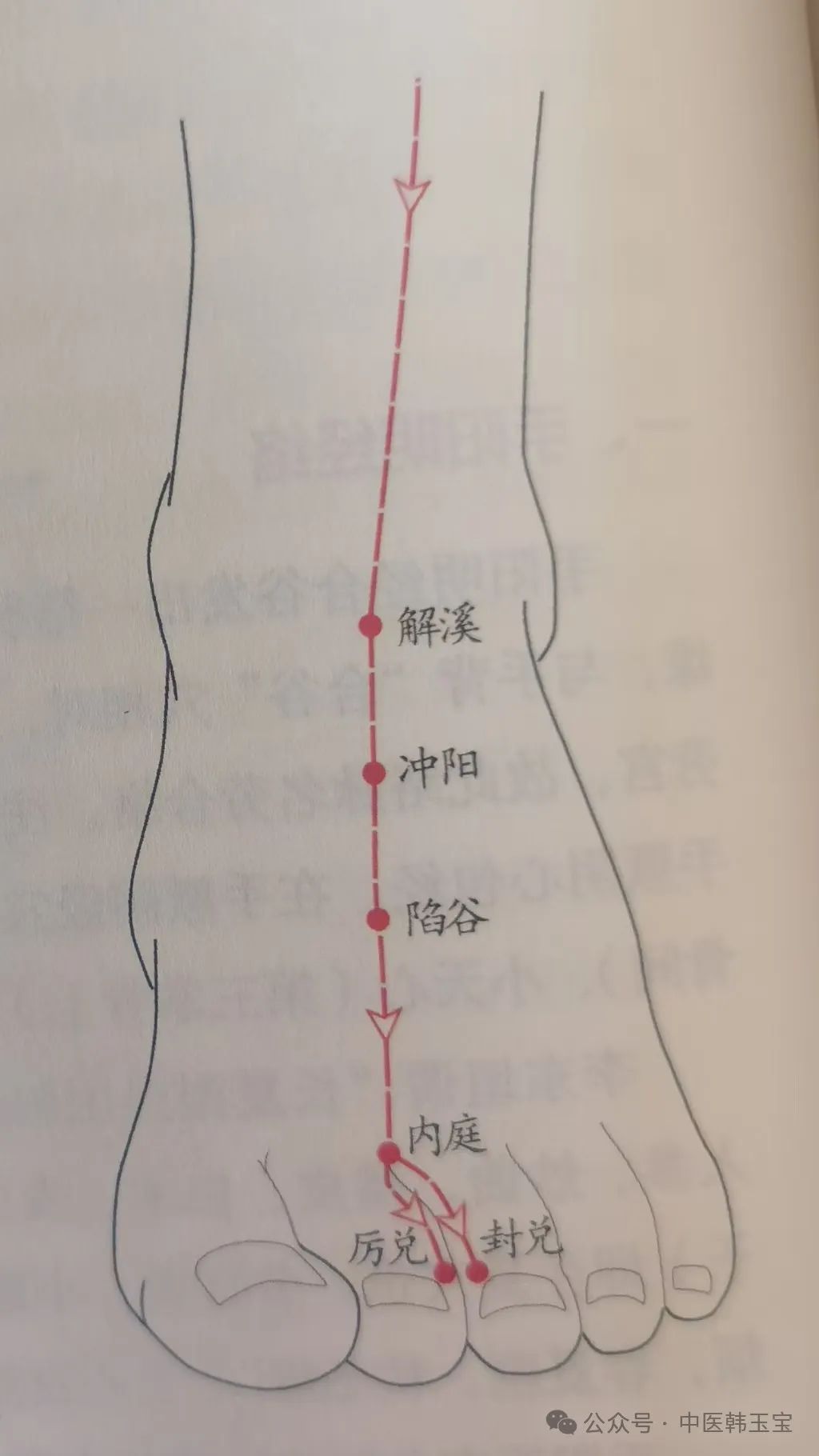 |
The Yangming Stomach Qi is abundant at Fenglong, which is located at the muscle bulge. Also, “long” means thunder rumbling.Fenglong is also written as “Fenglong”, the ancient thunder god.
Tang Piriyou’s “Huoshan Fu” states: “Shouting Fenglong, rushing to the gap, rumbling thunder, heaven and earth split apart.“
Thunder and lightning, clouds moving and rain falling. Rainwater flows down from the Jiexi, through Chongyang, up to high places, down to Xian Gu, like a waterfall falling into a pool, known as “flowing straight down three thousand feet, suspected to be the Milky Way falling from the nine heavens”. The pool converges at Neiting, a magnificent sight. Finally, it drains at Lidui and Fengdui.
Lidui is in the spirit, treating nightmares.
Fengdui is in the Qi, primarily for acid reflux and warm Qi.
Fenglong is located at the muscle bulge, on the outer side of the lower leg, 2 horizontal fingers from the anterior edge of the tibia. The Yangming Stomach Qi is abundant at Fenglong, this area is often struck by kicks, leading to Qi and blood disorder, unable to stand. The two horizontal fingers beside are the tibia, which has no muscle surrounding it, making it easy to injure or break when kicked.
The sole of the foot has Neiting, corresponding to the position of Neiting. The so-called unique points outside the meridian are not. This point and Neiting are actually in the same disturbance field, differing only in needling direction.
3. Hand and Foot Yangming Collaterals
My (Teacher Wu Xiongzhi’s) disciple Yingchun asked if there are collaterals at the meeting of Hand and Foot Yangming?
I observed at night, Yingxiang – Juyiao.
Yingxiang is the meeting point of Hand and Foot Yangming, and there is a collateral between Yingxiang and Juyiao, which can treat rhinitis and epistaxis. I named it Juyang Meridian, which can connect Yingxiang to Juyiao.
The “Neijing” states, “the fire is clearly burning its face“, hence it is also said, “facial heat indicates Foot Yangming disease.”
Hand and Foot Yangming encircle the face three times:
The inner circle is Hand Yangming, surrounding the face, namely, above Yingxiang, Yingxiang, and Kouhe, intersecting with the Ren Meridian at the water ditch. The “Neijing” mentions facial heat refers to the foot, not the hand, as Hand Yangming encircles the nose from the inside.
The middle circle is Foot Yangming, namely, Chengqi, Sibai, Juyiao, Dicang, intersecting with the Ren Meridian at Chengjiang.
The outer circle is Daying, Jiachuan, Xiaguan, Touwei, intersecting with the Ren Meridian at Chengjiang.
The Juyang Meridian is level with the intersection of the middle and lower facial areas, which is what Wu Jutong referred to as “the middle jiao is like a balance, not stable if not flat“.
4. Yangming Jueyin Collaterals
The main points on the back of the hand are Sanyang Meridian ( Taiyang, Shaoyang, Yangming) plus Chongyang Meridian ( Zhongchong – Laolong – Zhongkui 1 – Zhongkui 2 – Zhongkui 3 – Shangdu – Wailao Gong – Weiling – Qimen).
Zhongkui 1 is at the midpoint of the distal joint transverse line, close to the bone, treating hiccups.
The next joint transverse line midpoint is Zhongkui 2, treating esophageal obstruction.
The proximal joint high point is Zhongkui 3, treating warts and throat conditions (licking the female genital area causes confusion, warts grow in the throat).
These three points are located in the diaphragm, esophagus, and throat, all in the center of the body.
The Qimen point is Zhongquan, located at the transverse line on the back of the wrist, at the depression on the radial side of the extensor tendon, relieving distension (lung distension, stomach distension, hypochondriac fullness).
Laolong is located 0.1 cun behind the center of the middle phalanx of the middle finger. The “Baohong Tui Na Method” has a method for pinching the Laolong point: “This point is on the back of the middle finger, close to the nail, separated like chives, if a child is frightened to death, hold the spirit at Weiling and Qimen. If they do not wake up, pinch this point, it is painful and difficult to save.“
For children who are frightened, if severe, Laolong can show blue veins, pinching it disperses and revives the spirit.
In mild cases, blue veins can be seen between the eyebrows, in severe cases, abdominal pain, and passing blue stools. Blue indicates the liver. The dragon comes out of the fire, this cold air wraps it.
Zhongchong is in the Hand Jueyin, where Qimen connects to Yangming.
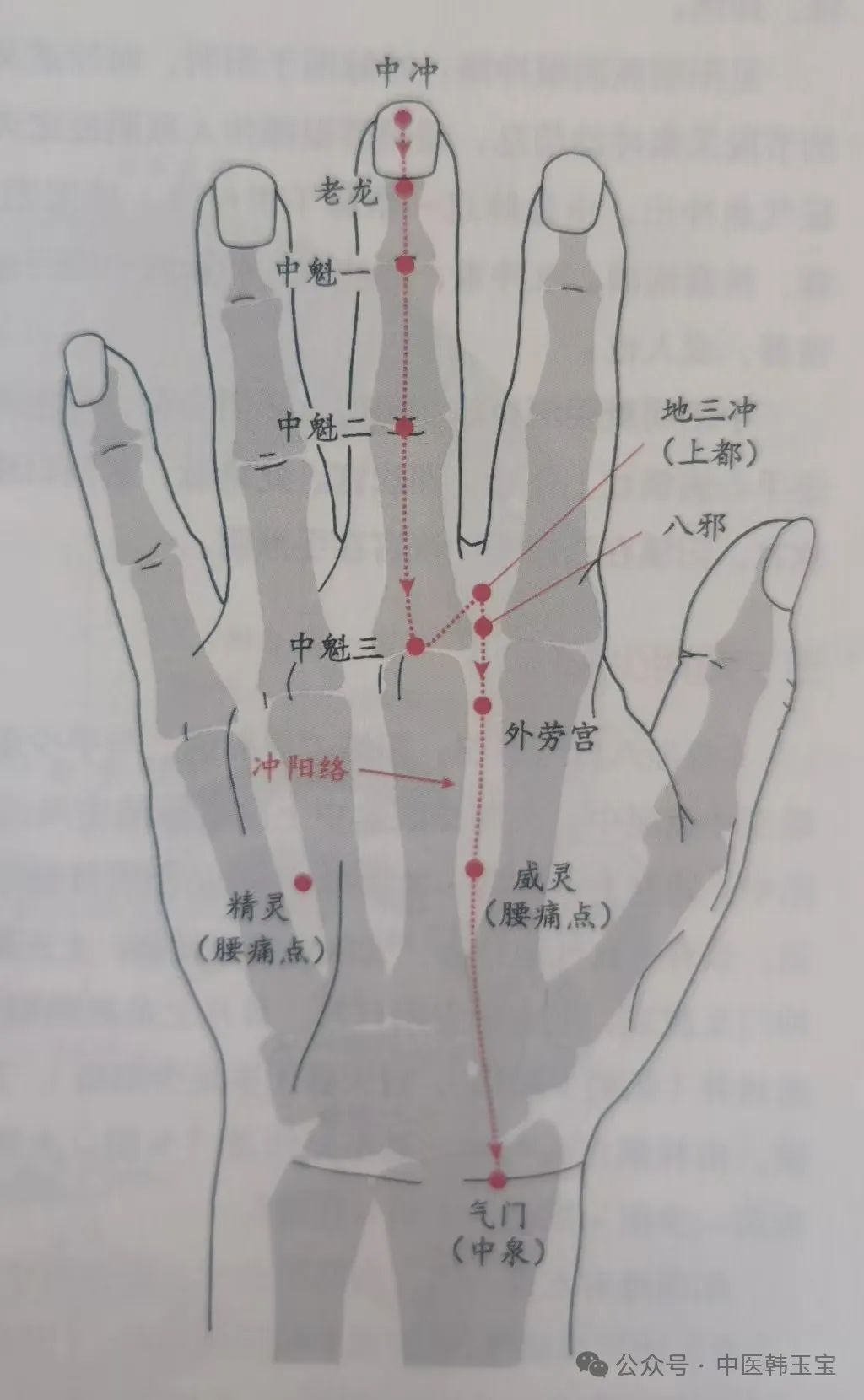 |
Blue veins can also be seen at the Yangwei point.Yangwei point is located at the root of the auricle, at the back side of the ear shell, level with the notch between the ear screen, pressing the ear root slightly below the point of the hearing point.
This point is in the Foot Shaoyang Gallbladder Meridian, can be moxibustion. If this point is tender, it often indicates tinnitus and deafness. After a child is frightened, this point can show blue veins, which can be moxibustion. It can also be placed on the Yangwei point, suddenly pulling the earlobe, calling their name, the head will respond automatically.
Shangdu – Wailao Gong – Weiling correspond successively to the throat, cervical vertebrae, lumbar vertebrae. The Di San Chong (Shangdu slightly behind the point) stops bleeding, and the Qimen point moves Qi.
The Di San Chong (Shangdu) runs from Di Er Chong to the palm, through Di Yi Chong to the opposite Di Er Chong, then ascends, both sides along the middle finger ascend to Zhongchong, in the middle finger, it is connected by Di Yi Chong, Ren Si Chong, Ren Yi Chong, Tian Er Chong through the collaterals to the Tian Yi Chong (Zhongchong).
Wailao Gong is also known as the pain-relieving point, treating all kinds of pain.
Wailao Gong and the midpoint of Di San Chong are Shou Jianjing, treating stiff neck, neck pain.
Foot Yangming Jueyin Root Chong Collateral: The Chong Meridian is connected to Yangming, while the Chong reverse is an important symptom of Jueyin. The Ren Meridian collects Chong impulse information in the segment of the Yin organ, transmitting it to the Tian Gen point of the Jueyin Meridian at the root of the Yin organ, thus the Jueyin Meridian connects with the Ren Meridian.
The Tian Gen Qi and blood surge out, passing through a collateral (Gen Chong Collateral) to transmit Yangming Meridian Qi, causing the vas deferens to contract, transporting semen to the seminal vesicle, filling the seminal vesicle. Qi surge indicates the connection of the Chong Meridian to Yangming. Thus, the Chong, Ren, and Du meridians all connect to Jueyin, descending to the reproductive organs, for adults.
Hand Yangming Jueyin He Kou Collateral: Yangming and Jueyin are connected, both governing the extreme phase of external heat diseases. Yangxi is also known as He Kou. This point does not run on the wrist crease but is one cun above, namely Kan Gong. This collateral is named He Kou Collateral.
Yangxi’s Yang runs to Yangchi.
Yangxi’s water runs to Kan Gong.
Yangxi is in Hand Yangming, while Kan Gong is in Hand Jueyin.
5. Yangming Shaoyang Collaterals
The “Study of the Eight Extraordinary Meridians” states: Yangwei “passes in front of the shoulder, meeting Hand Shaoyang at the Nao meeting, Tianjiao, the Nao meeting is three cun from the shoulder tip, Tianjiao is in the center of the depression at the upper edge of the scapula, meeting Hand and Foot Shaoyang, Foot Yangming at Jianjing in the center of the shoulder depression, one inch and five fen above the large bone in front of the Quepen.“
Thus, the Foot Yangming Stomach Meridian and Foot Shaoyang Gallbladder Meridian are connected at Quepen – Jianjing through the Yangwei Meridian.
My (Teacher Wu Xiongzhi’s) true Qi running method:(Zhou Tian Bu Qi Gong practice experience)
Qi flows from Yongquan to the kidney pit, up to the three Yin intersections, along the Foot Taiyin Spleen Meridian ascending to the groin, from Chongmen to the abdominal distress, ascending to the Foot Shaoyang Sun and Moon, ascending to the Foot Jueyin Qimen, ascending to the Foot Yangming Rugen, ascending to Quepen, connecting to Jianjing (Yangming Shaoyang Collaterals), passing through Tianjiao (Hand and Foot Shaoyang Collaterals), to Guanchong, descending through Jianjing to Quepen, descending to Dahong, merging into the Qihai.
The basic route is “Shaoyin – Taiyin – Shaoyang – Jueyin – Yangming – Shaoyang – Yangming – Jueyin – Shaoyang – Yangming – Taiyin – Ren Meridian”.
The Yangming Meridian has a waterway point, located three cun below the navel, two cun beside. I used this point to treat Sanjiao damp-heat, its effect is miraculous. The “Qianjin” treats Sanjiao heat, the “Dacheng” treats Sanjiao heat accumulation, the “Jia Yi” treats Sanjiao blockage, indicating this point connects to the Shaoyang Meridian.
Why does this point connect to the Shaoyang Meridian?
The Shaoyang Meridian’s Dai Mai point, Wushu point, and Weidao point all connect to the Dai Mai. Weidao can promote water and eliminate dampness, maintaining the waterway. This point connects to the waterway, thus the Dai Mai can treat leukorrhea as if sitting in water.
6. Yangming Du Meridian Collaterals
Chengqi is the meeting point of the Ren Meridian and Foot Yangming, I (Teacher Wu Xiongzhi) observed internally, “Chengqi – Jingming – Shangen” has a collateral, running separately from the Du Meridian, named Chengshan Meridian.
I (Teacher Wu Xiongzhi) during meditation observed Qi and blood flowing from Baihui down to Shangen, branching into three, respectively being the central Du Meridian, and the left and right from Jingming (the intersection of the Du Meridian and Foot Yangming) running separately to Chengqi, descending to the Ren Meridian.
 |
Copyright Statement
This article is excerpted from “Essentials of Acupuncture Six Meridians”, authored by Wu Xiongzhi, published by China Traditional Chinese Medicine Press, November 2024, First Edition.
The content of the article is for clinical thought reference only, sharing this article is for the purpose of dissemination and learning exchange, and does not take responsibility for the views of the article, for reference only. This article does not recommend any drugs or treatment methods, non-professionals should not self-diagnose, do not blindly try drugs, if there is discomfort, please seek medical attention offline. If there is any infringement, please contact us (hanyubao0927) for deletion.
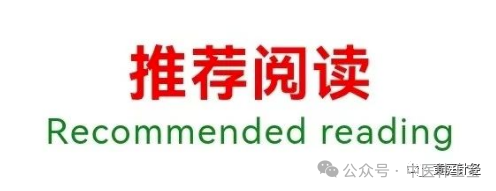
Meridian Theory I: Wu Men Meridian System – Taiyang Meridian
Meridian Theory I: Wu Men Meridian System – Hand and Foot Six Meridians
Meridian Theory I: Wu Men Meridian System – Eight Extraordinary Meridians
